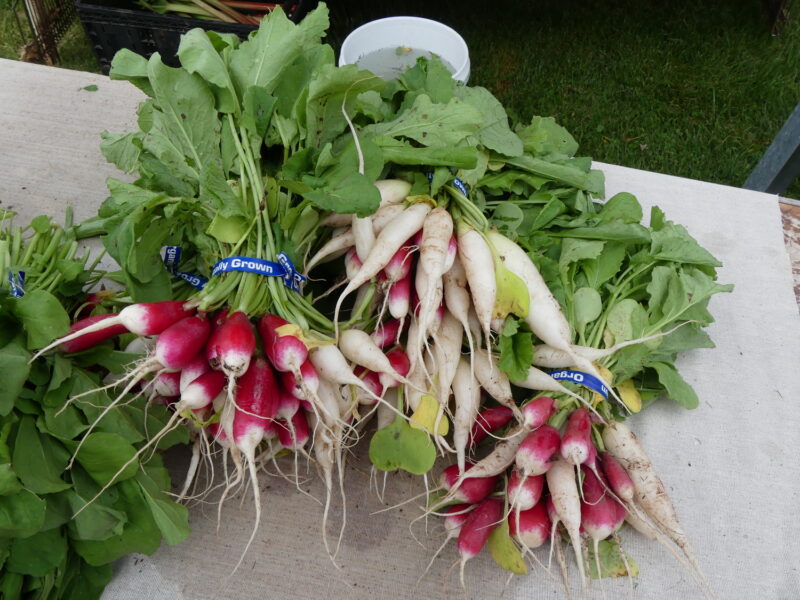

As you may have discovered from last week’s column there is more to a radish than just another pretty root, though most gardeners simply put all radishes into one large category — radish.
The fact of the matter is that radishes are divided into three cropping seasons and then into varieties. In the beginning, Western man only knew of the short-crop radish. They are generally mild, easy to grow and quick to mature. They’re a delight for gardeners anxious to have fresh vegetables for a spring or late fall salad, as they are ready to harvest in only 25 to 30 days from the time the seed is sown. They require cool soil to germinate and mild air temperatures to develop well so it’s not uncommon to find these as the first harbingers of the season to come.
One of the great unsung pluses of the early types is that they mature too early to be affected by the dreaded radish maggot, to be discussed shortly. Varieties to look for include Cherry Belle, Champion, Sparkler, Snow Belle, Easter Egg II Blend, French Breakfast and White Icicle.
For many years gardeners were limited to choosing between short- or long-crop radishes. Now there are Japanese varieties that can be sown in late spring or even early summer and harvested from midsummer into fall. These types grow more slowly, maturing in 45 to 60 days, but have been bred to resist bolting (flowering) during warmer weather. Like short-crop types, the midseasons are eaten raw, but the pungent skin is sometimes first peeled off. In this group you might want to try April Cross and Summer Cross, which may also be sold as daikon or Asian radishes.
The long(er)-season radishes are much larger and slower to mature (50-70 days) than short-crop varieties. Longer-season types need warm soil during germination and early growth, but short days and cool weather toward the end of their growing cycle. In this area they are planted midsummer for harvest in the fall. They store very well for use well through the fall and into early winter. These types may take from 50 to 70 days to mature and among the recommended are: Misato Rose, Round Black Spanish, Black Spanish Long, White Chinese, Sakurajima and German Beer (Munchner Bier).
Now that you know the choices, where do they get planted? All radishes need a sunny location and loose, even sandy, well-drained soil. If planted in heavy or clay soil or in soil that is too heavy in organic matter you are likely to have misshapen roots. In fact, most of the radishes, especially the long-rooted varieties, will benefit from being grown in raised beds where deep, loose soil can easily be provided. Before sowing the seeds though, work a small amount of general purpose organic fertilizer (though chemical fertilizers may be used for the early crops) into the soil. Since these are relatively fast crops, especially the early ones, fertilizing after the seedlings emerge is often of little use.
Other than seeds, soil and sun, the radish is not concerned about where it puts down its roots. If the garden plan includes slower germinating vegetables, tuck a few short-crop radish seeds at each end of the row to serve as row markers. By sprouting quickly they remind gardeners of the locations and eliminate the need to fuss with sticks, strings and tags.
Early radishes work well as companion crops, that is, interplanted with other vegetables. As the fast-maturing radishes are pulled out from the ground they loosen the soil and make room for slower growing roots like carrots and parsnips.
All radishes are grown from seed placed directly into the soil and never as transplants. The initial crop can be started in early spring, about four weeks before the first frost free date, which out here is from mid to late April. The seeds will germinate in cool soil, but they prefer soil temperatures above 60 degrees. Seedlings emerge in four to seven days and in the case of the early types, may be harvested only three weeks later.
As soon as you can work the soil sow the seeds at least one-half inch apart to a depth of about one half inch and allow about 8 to 10 inches between rows. Try to sow the seed as thinly as possible as plants grown closely together will have abundant leaves but small roots. Cover seeds lightly with fine soil, firm the soil in place gently then water with a fine mist. Sprouting will take place in a matter of days, but they’ll need a constant supply of soil moisture to do so.
Don’t make the big radish mistake. Unless your family can consume lots of radishes at one time, plan on sowing small amounts of seeds every week to 10 days (succession plantings) rather than raising one large crop. Radishes left in the ground past maturity become woody and can taste pretty bad.
Plump, juicy radishes are those that grow quickly and continuously. A steady supply of water, at least an inch a week, will ensure rapid, steady growth. Dry conditions produce tough roots, while overly wet conditions will result in cracked roots. A thin organic mulch laid down when the plants are 3 inches high will retain just enough moisture and help keep the soil cool.
Start harvesting short-crop radishes in three to four weeks when they are less than 1 inch in diameter. At this size they are crispy and at their flavor peak, but remember, once mature they go woody very quickly so even if you’re not ready and they are, yank ’em.
The only problem that I’ve ever encountered with radishes is the radish maggot (aka the cabbage root maggot) which will not affect the earlier crops, but may cause some problems as the soil warms. The maggots appear as disgusting, small white worms that tunnel in the root and make it rather unpalatable.
Chemicals should be out of the question, and it seems that the best control methods are to move your crop to a different spot each year (crop rotation), get planting done early and possibly skip a year now and then to reduce the potential infestation.
Plant your radishes in different spots every year to deter the maggot flies, and if you have a history of the maggots from previous plantings you can add some ashes or diatomaceous earth to the soil after the leaves emerge. Yellow sticky cards are also used to trap the adults and keep the females from laying eggs, but this only gives minimal control and crop rotation is still important.
The pupae of the maggot will overwinter in the soil and return to play havoc the following year. This is why planting in the same spot every year must be avoided. It can also help to plant a cover crop when the radishes are done as this will be a deterrent as well. Row covers can also be used as long as they are put up before the females lay eggs. Of course a row cover won’t work in an area where radishes grew last year since the pupae are probably already in the soil.
Early radishes can also be planted in planters at least 8 inches deep, in large pots and planting boxes. If these are used in alternate years, your radish crop may be able to outwit the maggots.
At harvest, trim the leaves(and use them in salads) close to the top of the root, place them in a plastic bag and store in the coolest part of the refrigerator. They will remain fresh tasting for two to four weeks, but only if bagged.
Now I don’t think I’ve ever had cooked radishes, but I have been told that when peeled and steamed the mid- and longer-season radishes can be cut and steamed with a resulting taste similar to turnips. They can also be julienned and added to stir-fry, or sliced thinly, battered and fried with other vegetables and meats for tempura dishes.
To go one step further, you can let some of your plants go to seed after flowering. The roots will be useless, but when the seed pods are still green and 1 to 3 inches long, break them off and chop them into small pieces. They add crunch to a salad and a peppery tang to a vegetable dish. Keep growing.
 More Posts from Andrew Messinger
More Posts from Andrew Messinger